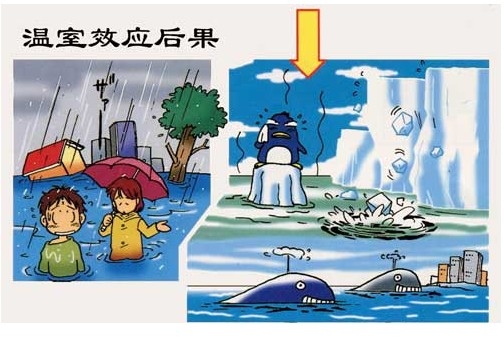(单词翻译:单击)

Science and Technology Greenhouse-gas monitoring Not hot air
科技 温室气体监测 而非热空气
A new, private initiative should help show which gases come from where
一项新的私人倡议或许能够表明各种气体从何而来
IN 1955 a young man called David Keeling started to measure the level of carbon dioxide in the Californian air. It seemed of little practical value, but he liked designing and building the equipment—and driving back and forth along the Pacific Coast Highway to his sampling site at Big Sur was fun. Scientists with a new-found interest in the world's carbon-dioxide levels soon learned of his work and gave him a job setting up monitoring stations in Hawaii and Antarctica for the Scripps Institute of Oceanography, in La Jolla. He continued to work there for almost 50 years, devoting his life to the monitoring effort. His son, Ralph, runs the carbon-dioxide programme at Scripps to this day.
1955年,一个名为David Keeling的年轻人开始测量加利福尼亚空气中的二氧化碳含量。当时他的这一举动看起来没什么实际价值,但这个年轻人喜欢设计和制造设备——乐此不疲的往返于太平洋海岸的高速公路和位于大苏尔的采样点间。新近对全球二氧化碳含量产生兴趣的科学家们得知他的所作所为后,给了他一份工作——在夏威夷和南极洲拉霍亚的斯克利普斯海洋研究所设立监测站。他一直在那里工作了差不多50年,倾其一生于监测事业。他的儿子拉尔夫现在管理着斯克利普斯的二氧化碳项目。
In those 50 years measuring carbon-dioxide levels has gone from being a fun problem for a postdoc to a crucial issue for the planet. But the amount of effort put into it remains surprisingly small. America's National Oceanic and Atmospheric Administration (NOAA) runs the biggest network of monitoring sites. A dozen other countries run a few here and there as well, with an expanded European effort getting under way. However, the scientists involved have been pointing out for years that it would take a very small investment, in a scientific world of satellites and supercomputers, to make such networks a lot more capable. On January 12th, such an investment was at last revealed—but not by any of the governments to which the pleas had been addressed.
在测量二氧化碳含量的这50年间,二氧化碳含量已不仅是一个博士后感兴趣的问题,而成为了全球至关重要的问题。但让人吃惊的是,为此所做的努力依然很少。美国国家海洋和大气局(NOAA)管理着最大的监测站网络。其它一些国家也在各处零星分布着一些网络,欧洲方面展开的努力正在进行中。然而,参与其中的科学家们几年前就指出,只要一些小额的投资以及科学界的人造卫星和超级计算机,就能使这些网络发挥更大的能力。1月12日,对监测网络的这类投资终于浮出水面——但政府方面没出上力,这些要求已得到解决。
A private company in Maryland, known until recently as AWS Convergence Technologies but now called Earth Networks, has announced that over the next five years it will spend $25m installing 100 state-of-the-art carbon-dioxide and methane monitors around the world. Fifty will be sited in America. According to Pieter Tans, the doyen of the field at NOAA, the country currently has 17 or 18, so that will improve things by a factor of four. In some less-well-covered places things will improve even more.
一家位于马里兰的私人公司——AWS集中技术——现在也叫地球网络,直到最近才为人所知,公司已经宣布在未来的五年里会花2500万美金在全世界范围内安装100台最先进的二氧化碳和甲烷监测器。其中50台将被安装在美国。据NOAA的元老级人物彼得.坦斯称,美国目前为止有17,18台,所以增加的监测器可增加到原来的4倍。在一些原本就覆盖很少的地方,将会有更多的监测器增加进来。
This is not pure philanthropy. Earth Networks, which already runs a large system of weather stations and lightning monitors, is looking to expand, and it believes that there should be a market for greenhouse-gas data. American states trying to show that they are doing something about their emissions might be prepared to pay for "inverse modelling" work (which uses measured gas levels and the weather patterns of recent hours and days to work out where the gas is coming from) if it were detailed enough to give results for areas as small as single states. So might countries in Europe, where the company plans to put 25 monitors. The new monitoring stations should allow such granularity.
此举并不纯粹是慈善事业。地球网络已经在运作一个大型气候站点系统,还将扩展闪电监测器,该公司认为温室气体数据应该能有市场。美国各州正试着表明他们现在对排放的气体所做的研究可能为"反转模型"工作做了准备("反转模型"指用已经测得的大气含量和近数小时及数天内的气候模型来猜测出这些气体是从哪来的)如果数据够完整,将可以得出单个州大小区域的结果。欧洲各国也准备采用这种"反转模型",公司计划在欧洲安装25台监测器。新的监测站应该允许这样的范围跨度。
Although carbon dioxide is the more important greenhouse gas, methane measurements will be a more practical early application to test the market for this sort of data. Land masses, and their inhabitants, emit methane without then sucking any of it back up, which makes inverse modelling easier than for carbon dioxide (which has sinks, in the form of photosynthesising plants, as well as sources).
尽管二氧化碳是更为重要的温室气体,但测量甲烷含量作为一个早期应用方法对测试此类数据的市场价值有更实际的作用。陆地,和生活在陆地上的各种生物,排放出甲烷后就不会吸回。用甲烷做研究的反转模型比用二氧化碳的要来的容易(因为二氧化碳可以被进行光合作用的植物吸收,也可能来源于植物的排放)
Dr Tans probably speaks for many of the scientists involved when he says he is cautiously optimistic about the news. The caution stems in part from concerns about how the company's policy on access to its data may change as its business model becomes clearer. To begin with, those data will be free to academic researchers. But that could change.
当坦斯博士称他对这个(投资)消息持谨慎乐观态度时,他很可能道出了众多参与其中的科学家们的态度。这种谨慎一部分源于担心地球网络很可能随着公司经营模式变得明晰而改变外界获得数据的政策。最先让人感到担忧的是现在这些数据都免费提供给学院的研究人员,但这个做法很可能会改变。
Another, more selfish worry is that governments which buy Earth Networks' products will close down their existing research programmes. Besides the resulting unemployment, some researchers fear this would waste an opportunity to use the new data to reveal the true workings of the sources and sinks of gases.
另一个更为自私一点的担忧是,政府如果买下了地球网络的产品后很可能停办掉他们现在的研究项目。这样做产生的后果除了让一些人失业外,有些研究人员还担心会浪费使用这些数据来真正揭示气体是何去何来的良机。
And new data there will be—possibly a lot of them—if the business shows signs of profit. Earth Networks will presumably expand, or competitors will move in, or both. Bob Marshall, the company's boss, says he could imagine 1,000 monitoring stations around the world by 2021. Couple such capability with new satellite measurements (America's Orbiting Carbon Observatory 2 is due to launch in a few years) and better measurements of the mass of plant life in forests and other ecosystems, and the planet's greenhouse-gas credits and debits will surely be understood far better.
如果企业表明了这些数据可以获利的一面,产生的新数据可能会很多。地球网络可能会扩张,或者竞争者加入进来。或者两者兼有。公司老板Bob Marshall说,他的设想是到2021年全世界范围有1000处监测站。新的人造卫星测量器的能力(美国计划在数年内发射轨道碳观测卫星2号)加之对森林和其他生态体系植物质量的更完善的测量,相信人们对地球温室气体的来源和出处会有更深层次的理解。
Such expansion has risks in itself. Long-term monitoring requires expertise that comes only with years on the job, so the quality of data from new entrants is always a bit suspect. Here, though, Earth Networks has been canny. As well as working with NOAA, it has a partnership with Scripps to ensure its precision and quality control. There's no better pedigree.
这样的扩张自身会存在风险。进行长期的监测需要专门技术,而这些检测技术只有通过经年累月的工作才能获得,因此新进的监测人员所监测到的数据在质量上总让人有些怀疑。在这方面,地球网络倒是很谨慎。除了和NOAA合作外,他们和斯克利普斯也有合作关系,这样做用以确保数据的精准性和质量控制。没有更好的合作者了。


